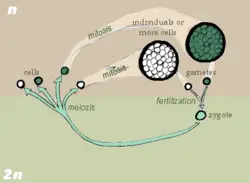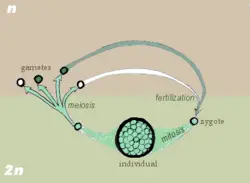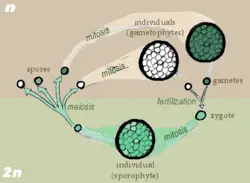Difference between revisions of "Life cycle" - New World Encyclopedia
Miriam Jones (talk | contribs) |
Miriam Jones (talk | contribs) |
||
| Line 1: | Line 1: | ||
{{Contracted}} | {{Contracted}} | ||
| − | A '''life cycle''' is the series of changes that an organism undergoes | + | A '''life cycle''' is the series of changes that an organism undergoes its inception through means of reproduction, whether through asexual reproduction or sexual reproduction, to the inception of the following generation in that same phase of the cyle. |
| + | |||
| + | |||
| + | ==Sexual Reproduction== | ||
| + | In regard to its ploidy (a multiple of the number of chromosomes in a cell), there are three types of cycles: | ||
*'''''haplontic''''' life cycle | *'''''haplontic''''' life cycle | ||
*'''''diplontic''''' life cycle | *'''''diplontic''''' life cycle | ||
| Line 7: | Line 11: | ||
These three types of cycles feature alternating [[haploid]] and [[diploid]] phases (''n'' and ''2n''). The haploid organism becomes diploid through [[fertilization]], which joins of [[gamete]]s. This results in a [[zygote]] which then [[germination|germinates]]. To return to a haploid stage, [[meiosis]] must occur (see [[Cell division]]). The cycles differ in the product of meiosis, and whether [[mitosis]] (growth) occurs. Zygotic and gametic meioses have one mitotic stage and form: during the ''n'' phase in zygotic meiosis and during the ''2n'' phase in gametic meiosis. Therefore, zygotic and gametic meiosis are collectively term '''haplobiontic''' (single meiosis per phase). Sporic meiosis, on the other hand, has two meiosis events ('''diplobiontic'''): one in each phase. | These three types of cycles feature alternating [[haploid]] and [[diploid]] phases (''n'' and ''2n''). The haploid organism becomes diploid through [[fertilization]], which joins of [[gamete]]s. This results in a [[zygote]] which then [[germination|germinates]]. To return to a haploid stage, [[meiosis]] must occur (see [[Cell division]]). The cycles differ in the product of meiosis, and whether [[mitosis]] (growth) occurs. Zygotic and gametic meioses have one mitotic stage and form: during the ''n'' phase in zygotic meiosis and during the ''2n'' phase in gametic meiosis. Therefore, zygotic and gametic meiosis are collectively term '''haplobiontic''' (single meiosis per phase). Sporic meiosis, on the other hand, has two meiosis events ('''diplobiontic'''): one in each phase. | ||
| − | == Haplontic life cycle == | + | === Haplontic life cycle === |
[[Image:Zygotic meiosis.png|thumb|250px|Zygotic meiosis]] | [[Image:Zygotic meiosis.png|thumb|250px|Zygotic meiosis]] | ||
| Line 20: | Line 24: | ||
* Many [[protozoa]] | * Many [[protozoa]] | ||
| − | == Diplontic life cycle == | + | === Diplontic life cycle === |
[[Image:Gametic meiosis.png|thumb|250px|Gametic meiosis]] | [[Image:Gametic meiosis.png|thumb|250px|Gametic meiosis]] | ||
| Line 32: | Line 36: | ||
* Some [[brown algae]] | * Some [[brown algae]] | ||
| − | == Diplobiontic life cycle == | + | === Diplobiontic life cycle === |
[[Image:Sporic meiosis.png|thumb|250px|Sporic meiosis]] | [[Image:Sporic meiosis.png|thumb|250px|Sporic meiosis]] | ||
| Line 43: | Line 47: | ||
Sporic meiosis occurs in [[plant]]s and many [[alga]]e. Having multicellular individuals in both phases means that for some [[seaweed]]s, it is difficult to determine if a macroscopic specimen is gametophytic or sporophytic unless observed under a microscope, this is called isogamy. However, not all species with sporic meiosis have both large gametophyte and sporophyte generations. The trend in [[higher plant]]s is having smaller gametophytes that are more dependent and [[parasitic]] on sporophytes, a phenomena known as heterogamy. | Sporic meiosis occurs in [[plant]]s and many [[alga]]e. Having multicellular individuals in both phases means that for some [[seaweed]]s, it is difficult to determine if a macroscopic specimen is gametophytic or sporophytic unless observed under a microscope, this is called isogamy. However, not all species with sporic meiosis have both large gametophyte and sporophyte generations. The trend in [[higher plant]]s is having smaller gametophytes that are more dependent and [[parasitic]] on sporophytes, a phenomena known as heterogamy. | ||
| + | |||
| + | |||
| + | ==Asexual Reproduction== | ||
| + | In cases of asexual reproduction, the life cycle is complete in one generation, where an individual inherits all of its chromosomes from one parent and is genetically identical to its parents. Prokaryotes, such as [[bacteria]], undergo ''binary fission,'' where each [[cell (biology)| cell]] divides in half to form two cells with identical [[DNA]] to the original [[cell (biology)| cell]]. In order for the original cell divide, the [[prokaryote|prokaryotic]] chromosome that is a single [[DNA]] molecule must first replicate and then attaches itself to a different part of the [[cell (biology)|cell]] membrane. Most protists, unicellular [[eukaryote]]s, also reproduce asexually, except under stress they reproduce sexually. | ||
| + | |||
| + | Many multicellular organisms also have the ability to reproduce asexually. Many such organisms will bud off a localized cluster of cells, which then grows through [[mitosis]] to form a new individual. Animals such as sponges can reproduce by fragmenting their bodies. Many [[plant]]s have the ability to reproduce asexually as well. | ||
| + | |||
==Life history theory== | ==Life history theory== | ||
Revision as of 13:52, 22 June 2006
A life cycle is the series of changes that an organism undergoes its inception through means of reproduction, whether through asexual reproduction or sexual reproduction, to the inception of the following generation in that same phase of the cyle.
Sexual Reproduction
In regard to its ploidy (a multiple of the number of chromosomes in a cell), there are three types of cycles:
- haplontic life cycle
- diplontic life cycle
- diplobiontic life cycle (also referred to as diplohaplontic, haplodiplontic, or dibiontic life cycle)
These three types of cycles feature alternating haploid and diploid phases (n and 2n). The haploid organism becomes diploid through fertilization, which joins of gametes. This results in a zygote which then germinates. To return to a haploid stage, meiosis must occur (see Cell division). The cycles differ in the product of meiosis, and whether mitosis (growth) occurs. Zygotic and gametic meioses have one mitotic stage and form: during the n phase in zygotic meiosis and during the 2n phase in gametic meiosis. Therefore, zygotic and gametic meiosis are collectively term haplobiontic (single meiosis per phase). Sporic meiosis, on the other hand, has two meiosis events (diplobiontic): one in each phase.
Haplontic life cycle
A zygotic meiosis is a meiosis of a zygote immediately after karyogamy, which is the fusion of two cell nuclei. This way, the organism ends its diploid phase and produces several haploid cells. These cells divide mitotically to form either larger, multicellular individuals, or more haploid cells. Two opposite types of gametes (e.g., male and female) from these individuals or cells fuse to become a zygote.
In the whole cycle, zygotes are the only diploid cell; mitosis occurs only in the haploid phase.
The individuals or cells as a result of mitosis are haplonts, hence this life cycle is also called haplontic life cycle. Haplonts are:
Diplontic life cycle
In gametic meiosis, instead of immediately dividing meiotically to produce haploid cells, the zygote divides mitotically to produce a multicellular diploid individual or a group of more diploid cells. Cells from the diploid individuals then undergo meiosis to produce gametes. The haploid gametes do not divide mitotically, however. Without growing larger, the gametes would fuse and produce the diploid zygote with gametes of the opposite type.
In the whole cycle, gametes are the only haploid cells; mitosis occurs only in the diploid phase.
The diploid multicellular individual is a diplont, hence a gametic meiosis is also called a diplontic life cycle. Diplonts are:
- Animals
- Some brown algae
Diplobiontic life cycle
Main article: Alternation of generations
In sporic meiosis, also known as intermediary meiosis, mitoses occur in both the diploid and haploid phases. It exhibits alternation of generations, which features of spore-producing multicellular sporophytes and gamete-producing multicellular gametophytes. Diagramatically, sporic meiosis looks like the complex halves of gametic meiosis and zygotic meiosis are merged into one.
This type of cycle is diplobiontic (also known as diplohaplontic, haplodiplontic, or dibiontic).
Sporic meiosis occurs in plants and many algae. Having multicellular individuals in both phases means that for some seaweeds, it is difficult to determine if a macroscopic specimen is gametophytic or sporophytic unless observed under a microscope, this is called isogamy. However, not all species with sporic meiosis have both large gametophyte and sporophyte generations. The trend in higher plants is having smaller gametophytes that are more dependent and parasitic on sporophytes, a phenomena known as heterogamy.
Asexual Reproduction
In cases of asexual reproduction, the life cycle is complete in one generation, where an individual inherits all of its chromosomes from one parent and is genetically identical to its parents. Prokaryotes, such as bacteria, undergo binary fission, where each cell divides in half to form two cells with identical DNA to the original cell. In order for the original cell divide, the prokaryotic chromosome that is a single DNA molecule must first replicate and then attaches itself to a different part of the cell membrane. Most protists, unicellular eukaryotes, also reproduce asexually, except under stress they reproduce sexually.
Many multicellular organisms also have the ability to reproduce asexually. Many such organisms will bud off a localized cluster of cells, which then grows through mitosis to form a new individual. Animals such as sponges can reproduce by fragmenting their bodies. Many plants have the ability to reproduce asexually as well.
Life history theory
In animal and human biology life history theory is a method of understanding evolved behaviors and strategies to optimize reproductive success.
Credits
New World Encyclopedia writers and editors rewrote and completed the Wikipedia article in accordance with New World Encyclopedia standards. This article abides by terms of the Creative Commons CC-by-sa 3.0 License (CC-by-sa), which may be used and disseminated with proper attribution. Credit is due under the terms of this license that can reference both the New World Encyclopedia contributors and the selfless volunteer contributors of the Wikimedia Foundation. To cite this article click here for a list of acceptable citing formats.The history of earlier contributions by wikipedians is accessible to researchers here:
The history of this article since it was imported to New World Encyclopedia:
Note: Some restrictions may apply to use of individual images which are separately licensed.


